Lise Lefebreve è una designer francese appena diplomata al master department della Design Academy di Eindhoven. Ci è stata segnalata qualche tempo fa dai nostri soliti amici fidati.
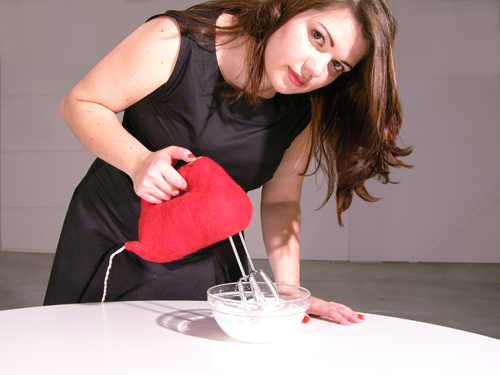
The aesthetic of domestic sounds è il titolo della sua tesi di master, dedicata allo studio di skin acustiche per oggetti domestici rumorosi, un lavoro a metà strada tra product design e sound design.
A dire la verità la cara Lise, nonostante la sua innata simpatia (le foto parlano da sole), rappresenta per noi un’occasione di discussione. I suoi vestiti sonori per oggetti d’uso quotidiano non lasciano indifferenti. Ogni volta che abbiamo presentato il suo lavoro non sono mancati giudizi opposti e critiche spesso feroci. Ma come volerle del male?
Ecco allora questa interessante intervista (in doppia lingua), che descrive la proposta di un soundscape domestico ad opera di un product designer, piuttosto che di un sound designer.
Cara Lise, ll tuo lavoro propone un forte legame tra suono e design degli oggetti d’uso quotidiano. Secondo il tuo parere, le persone sono pronte per questo?
Credo di sì. I dispositivi oggi sono diventati molto affidabili ed efficienti e credo che i consumatori desiderano caratteristiche che fanno la differenza. Se si hanno a disposizione 15 lavatrici che lavano i vestiti nello stesso modo, ma una sola di loro fa il lavoro in silenzio, questa cratteristica la rende più appetibile.
Ma penso anche le persone stanno diventando più attente agli oggetti che comprano e che mettono nelle loro case. E’ una questione di qualità della vita. Negli ultimi 10 anni gli europei hanno dato maggiore attenzione all’inquinamento sonoro e c’è una richiesta di prodotti non solo silenziosi, ma anche di prodotti il cui suono è stato progettato, nel senso che qualcuno ha pensato il suono di un dispositivo in relazione alla sua funzionalità e alla risposta emozionale che crea negli utenti.
Nonostante ci sia ancora molto da fare sull’inquinamento del suono nello spazio pubblico, ritengo che sia importante iniziare con gli oggetti d’uso quotidiano. Ci sono cose che ci circondano nel nostro spazio, che sono oggetti su cui si può avere un controllo diretto. Anche se non si può fare nulla per gli aerei che volano sopra le nostre teste o per l’autostrada che ci sta vicina, è possibile scegliere di acquistare un frigorifero che non tenga sveglio durante notte e di una lavastoviglie che non copra le conversazioni in cucina .
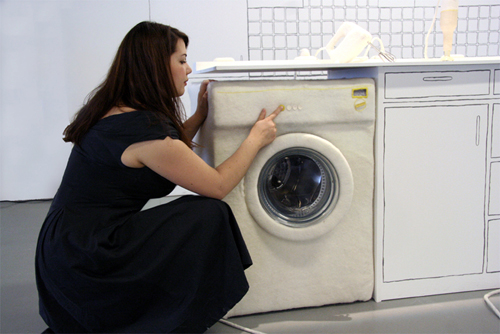
Un nuovo soundscape domestico: il silenzio è sovrano?
Nel complesso, sì. Ma il sound design vuol dire anche cura per i dettagli. E’ una questione di comunicazione più che di decibel. Si tratta di qualità del suono.
Design del suono non vuol dire riduzione del rumore, ma consiste nel decidere quale suono è adatto a trasmettere il messaggio corretto o la corretta atmosfera nel momento in cui si interagisce con un oggetto. Consiste nel decidere il suono di accensione delle luci o il suono di connessione tra due componenti. E’ il suono del BIP quando diverse opzioni vengono selezionate, e il suono del motore che permette di sapere se sta funzionando correttamente, senza avere un volume troppo elevato.
Credo che il silenzio sia il passo n. 1. Una volta realizzato un canvas vuoto di suono, è più facile applicare suoni definiti e ben progettati, che possono migliorare la comunicazione e la qualità dell’interazione con l’oggetto.
Il tuo lavoro unisce insieme product design, social impact, sound design, emotional design. L’industria è pronta per proporre un nuovo prodotto?
Finora ho lavorato con l’industria ad un livello più concettuale. Ho proposto nuovi approcci al silenzio che sono già in fase di sviluppo. L’industria è quindi pronta per cominciare, ma la questione è se il consumatore è pronto a rispondere. Comunque la mia attività in questo momento è ancora molto riservata e non posso dire altro …
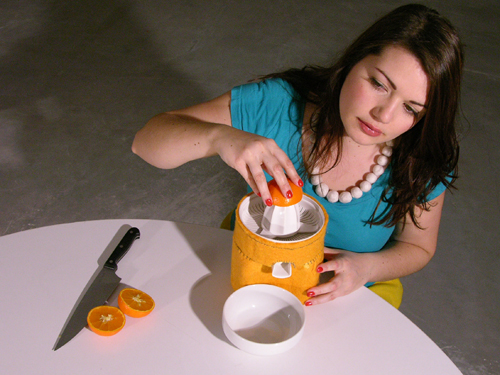
Hai fatto dei test con gli utenti / consumatori? Immagino che questo sia un punto molto critico. Che tipo di misure hai effettuato?
No, non per gli oggetti che ho creato nella mia tesi. Ho fatto delle proposte, creando delle illustrazioni dei miei argomenti, ma comunque non erano destinate ad un lancio diretto sul mercato, ho ritenuto che un test svolto in modo tradizionale sui miei oggetti sarebbe stato irrilevante.
Tuttavia ho avuto una risposta molto positiva alle exhibition in cui è stato presentato il mio lavoro. I visitatori sono stati attratti inizialmente dalla natura degli apparecchi, successivamente hanno cominciato a utilizzarli. I bambini in particolare sono impazziti, e sono arrivati a trattare l’aspirapolvere come un animaletto da compagnia 🙂
Puoi dirci qualcosa sulle tue prossime attività ?
Al momento mi sto dedicando maggiormente allo sviluppo della parte tessile del mio lavoro, piuttosto che alla parte sonora:-)
Oltre alla consulenza per la società di cui ho parlato prima, sto lavorando come designer per il TextielLab, che è un istituto di ricerca nonchè laboratorio di sviluppo per tutti i materiali tessili che apprtengono all’Audax Textiel Museum di Tilburg, nei Paesi Bassi.
Il mio obiettivo principale in questo momento lo studio della tecnica del seamless 3D knitting e la ricerca di texture e pattern tramite ricamo digitale e taglio al laser.
Parte del mio lavoro si risolve nella creazione di prodotti venduti negli shop dei musei e un’altra parte si traduce invece in ricerche sperimentali per l’archivio dei filati, etc ..
E ‘come lavorare in un grande parco giochi che è per metà morbido e fluffy e per l’altra metà high-tech!
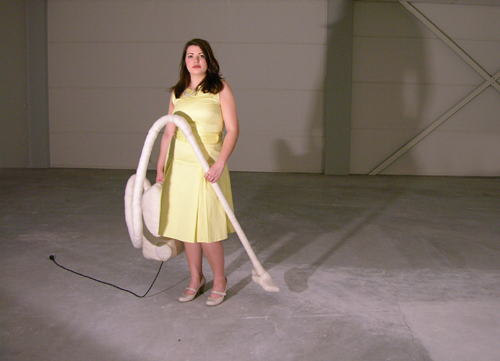
English version
Your work propose a strong connection between sounds and design of everyday objetcs. According to your opinion, are people ready for this?
I think so, yes. Our appliances have become quite reliable and efficient and I think customers are looking for the features that will make a difference. If you have a choice between 15 washing machines that will wash your clothes well, but one of them does the job silently, it becomes a good selling point. But I also think people are getting more picky about the objects they buy and put in their homes. It’s about quality of life. I would say in the last 10 years europeans are paying more attention to sound pollution and there is a demand for quiet products but also products whose sound is designed, in the sense that someone has been thinking about the sound the appliance makes in regards to its function and the emotional response it creates in the user.
And while there is a lot still to be done about sound pollution in the public space, I think it’s important to start with everyday objects. These are the things you are surrounded with in your own space, but they are also objects you have direct control over. While you can’t easily do anything about the planes that fly over your head or the highway running close, you can chose to buy a fridge that won’t wake you up at night and a dishwasher that doesn’t hinder conversations in the kitchen.
A new domestic soundscape: silence is king, isn’t it?
Overall, yes. But sound design is also about the details. It’s more about communication than about decibels. It’s about the quality of the sound as well. Sound design is not noise reduction, it’s deciding which sound is appropriate to convey the right message or atmoshphere when interacting with an object. It’s deciding the sound of switching on the lights or the sound of locking two components together. It’s the sound of the “bip” when you select different options, and the sound of the motor that lets you know it’s working properly without being loud. I think silence is step n°1. Once we achieve a “blank canvas” of sound, it’s easier to apply thoughtfull and refined sounds that enhance communication and interaction quality with the object.
your work mixes together product design, social impact, sound design, emotional design. Are industries ready to propose a new product?
So far I’ve been working with the industry on a more conceptual level, brainstorming and bringing new approaches to silent ranges that are already being developed. So the industry is ready to give it a shot, the question is now whether or not the consumer will respond to it. But it’s still quite confidential so I can’t develop too much on this…
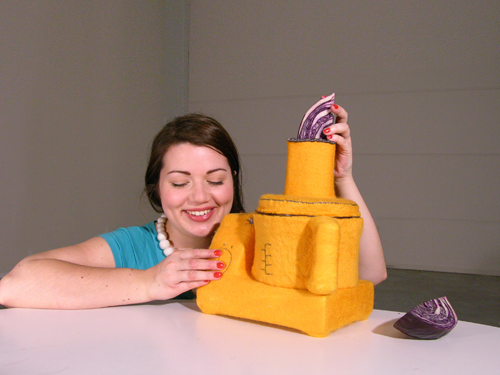
Did you make some test with users/consumers? I guess this is a very critical point. What kind of values do you measure?
No, not on the objects I created for my thesis. I made them as a proposal, as a visual illustration of my topic, but they’re not intended for a direct launch on the market, so in that sense I felt that testing them in the traditional way appliances are tested would be irrelevant.
However from the exhibitions my project was displayed at, the response was quite positive. Visitors were mainly drawn to the cuddly and soft nature of the appliances before they turned them on to try them. Children especially were very fond of them, treating the vacuum cleaner like a family pet 🙂
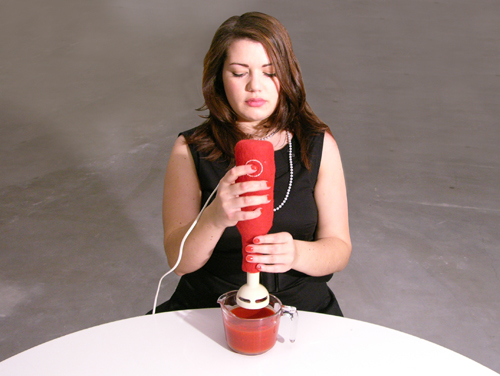
Can you tell us something about your next works and activities?
At the moment I am developing more the textile part of my work than the sound part 🙂
Besides consulting for the appliance company i mentioned earlier, I’m working as a designer for the TextielLab, which is a research and development lab for anything textile related that belongs to the Audax Textiel Museum in Tilburg, The Netherlands.
My main focus there at the moment is seamless 3D knitting and research in textures and patterns using digital embroidery and laser cutting.
Part of my work ends up as products sold in the museum shop and part of it is expiremental research for the yarn library etc…
It´s like working in a big playground that is half soft and fluffy and half high tech!
- These two women will save the future of Sound Art with a web radio called Radio Papesse - June 20, 2016
- #SayItWithSound Contest: Sonify your World and Win - December 21, 2015
- Sound Technician at University of Greenwich - December 1, 2015





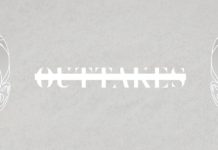




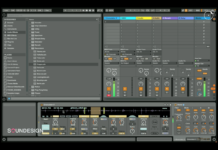
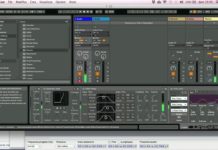

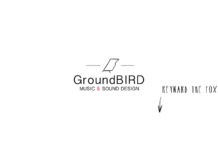
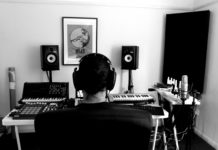


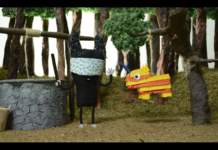
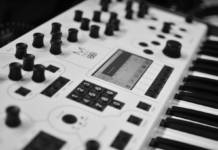
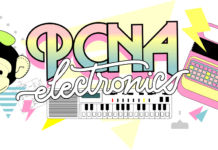


[…] si sono occupati di un tema che calza a pennello con quelli affrontati da Gianpaolo nell’intervista a Lise, ovvero: il suono negli oggetti, e in particolare, il suono degli oggetti […]